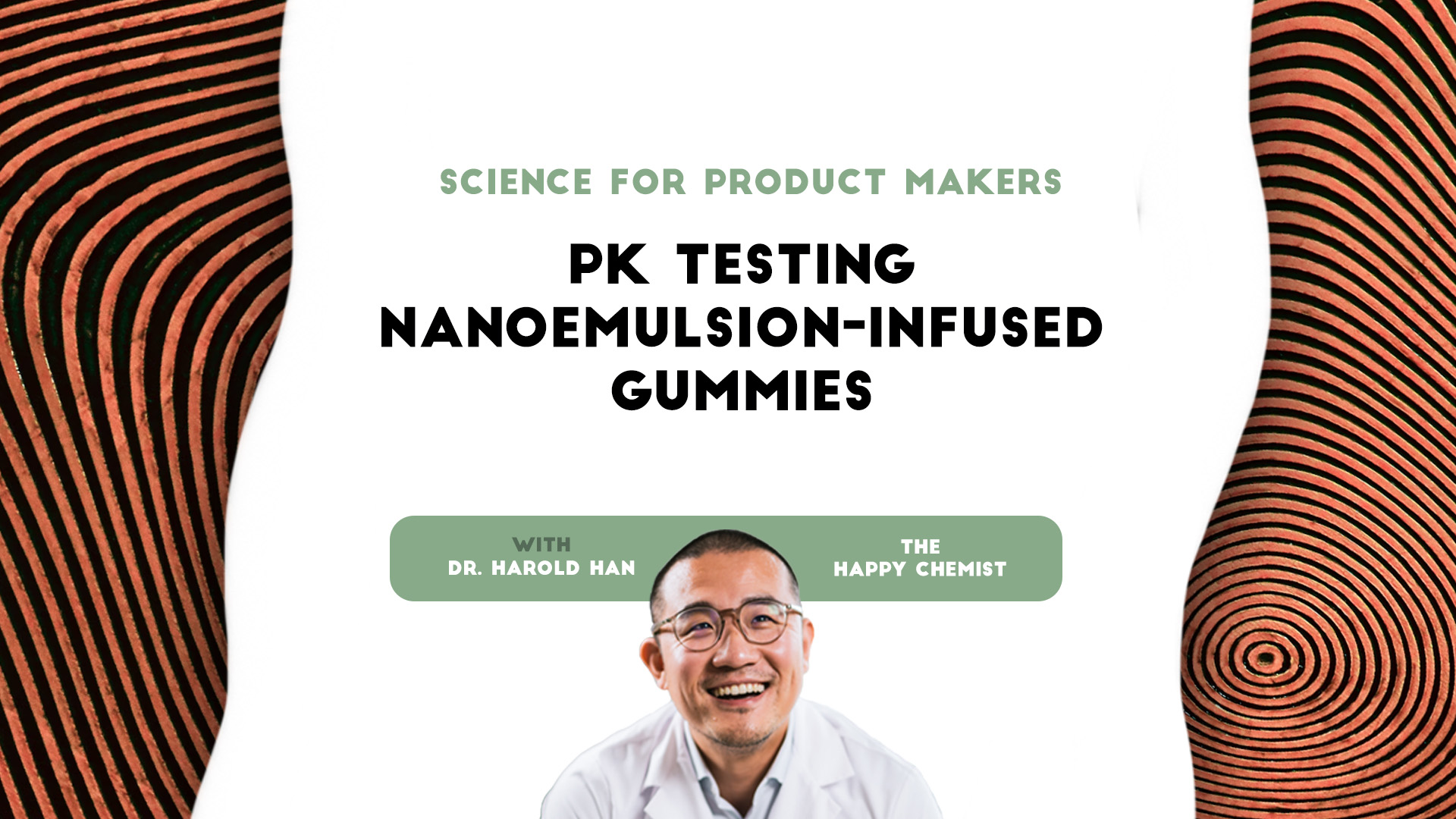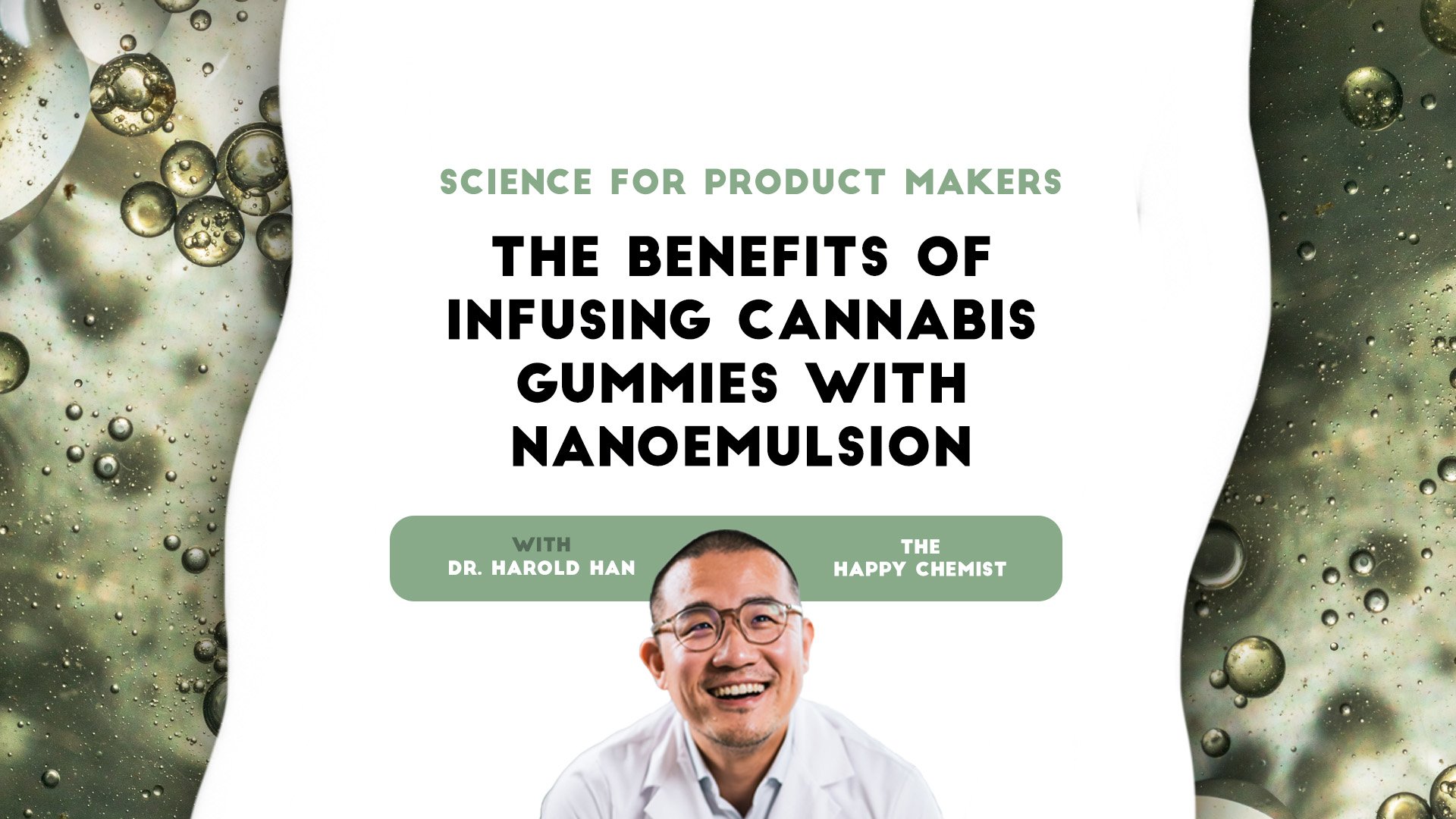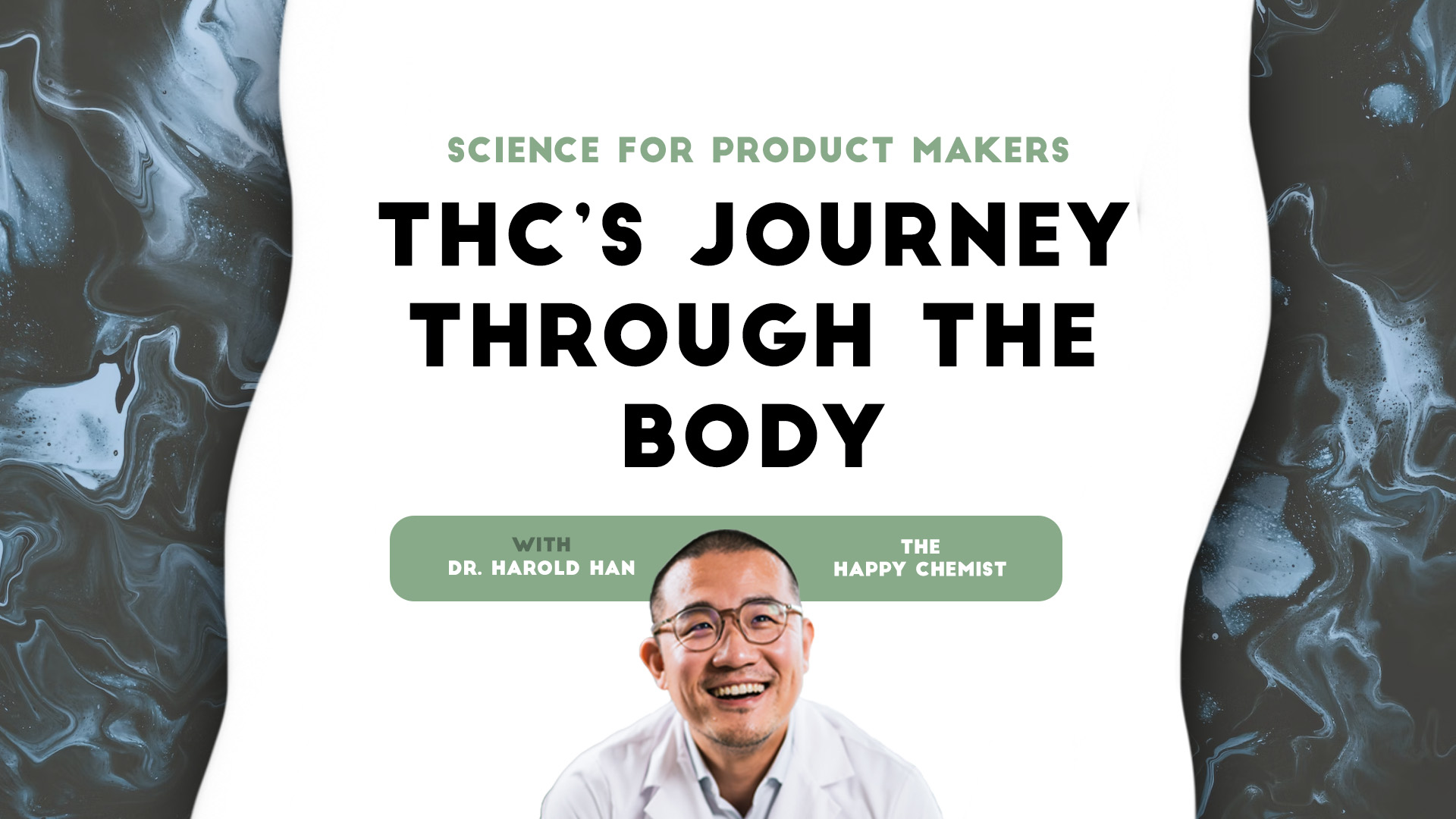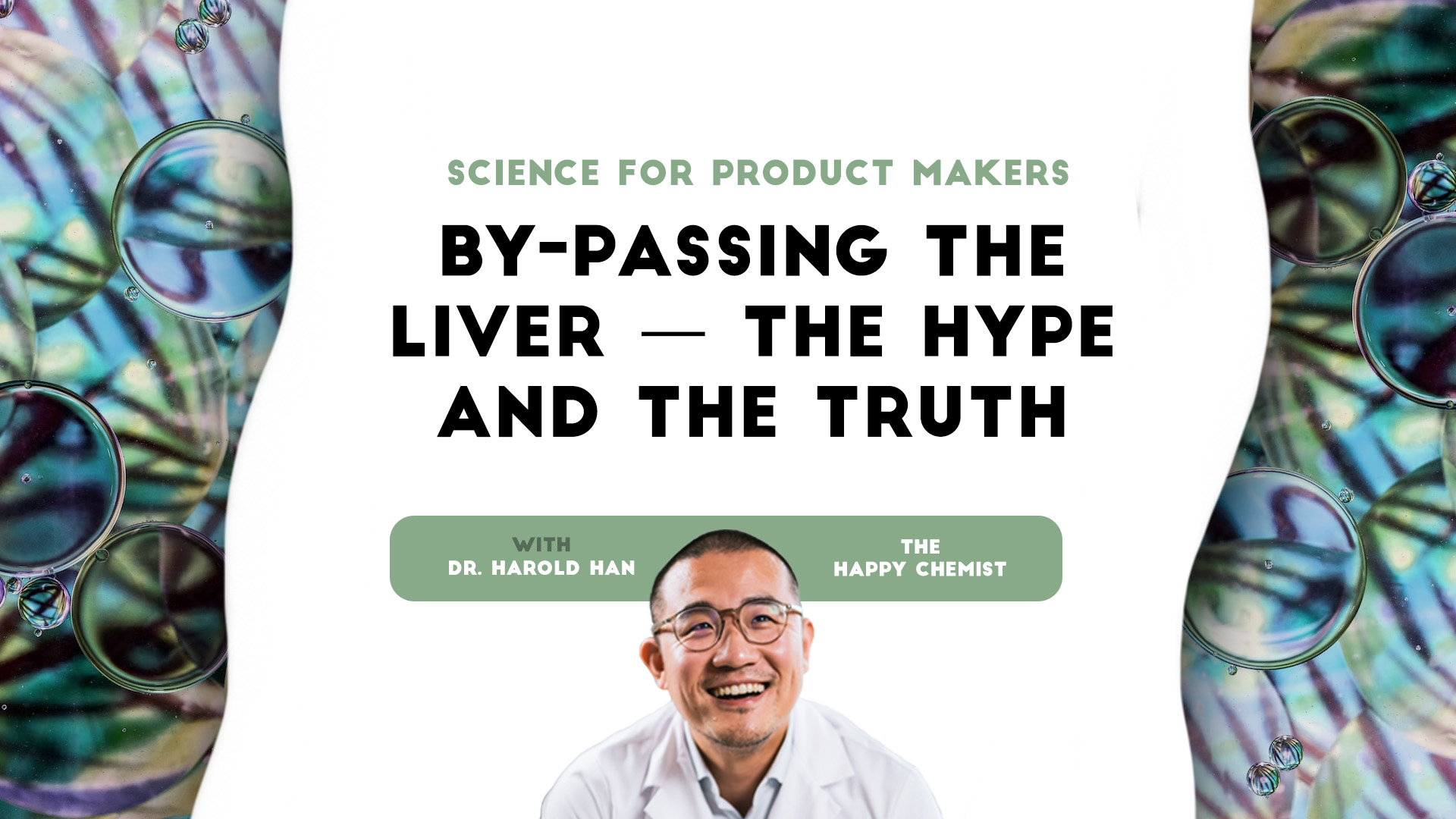Science for product makers: the benefits of infusing cannabis gummies with nanoemulsion
This post is also published as an article on Harold's LinkedIn profile. You can read and leave comments here.
5 min read
 Dr. Harold Han - "The Happy Chemist"
:
6/29/24 9:24 PM
Dr. Harold Han - "The Happy Chemist"
:
6/29/24 9:24 PM

My last article discussed the advantages of using nanoemulsion in gummies. Many people voted for "quick onset" as their most desired feature, which several experts think could set a new standard for infused edibles.
But how can we truly test and verify that these gummies work quickly? Sure, consumers can try the products and see the effects for themselves. However, there's also a scientific approach called pharmacokinetics (PK) that leverages human blood analysis to directly prove how effective an infused product is.
Pharmacokinetics (PK) and Pharmacodynamics (PD) are important metrics to evaluate how drugs interact with the body. In simple terms, PK looks at how the body processes a drug, which can be seen by changes in drug levels in the blood over time. PD looks at how the drug impacts the body, including medical benefits, recreational effects, changes in mood, and any impairments.
Here is what a basic human PK operation looks like:
For each volunteer, we end up with several blood samples taken at different times. A special process is used on all the samples to extract THC and its metabolites. Then their concentrations are measured using a technique called HPLC (High-Performance Liquid Chromatography). This allows us to see how quickly THC enters the bloodstream, how high the concentration gets, and how long it stays at that level. If we can test the same volunteers with a different formulation, we can compare the effectiveness between the two formulations.
The procedure might seem straightforward, right? However, it can be quite challenging, especially when it involves THC. In 2022, the Vertosa team successfully conducted a human PK study to compare nanoemulsion-infused THC gummies with distillate-infused THC gummies.

People generally believed getting IRB approval was the most challenging step of conducting a human THC PK study — they were right!
Conducting human blood tests with a Schedule 1 substance like THC in the USA has strict regulations. In my last poll, people generally believed getting IRB approval was the most challenging step of conducting a human THC PK study. They were right. To ensure the safety of our volunteers, our study had to be reviewed and approved by the Institutional Review Board (IRB). It took us over 8 months to get this approval. We had to partner with a certified research facility, establish and validate methods for blood extraction and measurement, hire certified phlebotomists, prepare all necessary materials, and run rehearsals to make sure everything would go smoothly on the day of the study.
The study was conducted over two separate days, two weeks apart, to test the two different gummy formulas. The same six volunteers participated on both days, including four men and two women, all with different body weights and cannabis usage habits.
Subjects arrived at the lab around 8 am on empty stomachs. They were asked to avoid using cannabis for at least three days before the test. This was to make sure their initial blood samples didn't have any residual THC, giving us a clear baseline to start from.
We started by drawing the initial blood sample and then gave the volunteers a 15mg THC gummy, which was infused either with Vertosa nanoemulsion or distillate. The study was conducted in a blind manner, meaning the testers didn't know which type of formulation they were consuming.
After eating the gummy, we drew blood at the following times: 5, 10, 15, 30, 45, 60, 90, 120, 180, 270, 360, and 450 minutes. The first hour had the most frequent blood drawings. To manage this, we staggered the start times for each tester, allowing one phlebotomist to handle two testers.

Food plays a significant role in pharmacokinetics (PK), especially in how THC is absorbed. You can find more details in my previous article on this topic. We started the study with the volunteers having not eaten anything, and then provided food at the 120-minute mark. We chose a specific type of food (pizza and salad) to control for total fat and calories. We also made sure to serve the same menu on both testing days to keep the food's impact consistent across all results.
All in all, the entire process lasted over 8 hours. Don’t worry — our volunteers were kept comfortable with blankets, resting beds, and video games. It was a fun day for everyone!

For each time point, we quantified THC and its two metabolites, 11-OH-THC and THC-COOH. Let’s take a look at THC first. When looking at the individual curve of the THC concentration between distillate-infused gummies and nanoemulsion-infused gummies, we saw some clear differences.
We observed high variations in Tmax (the time to reach maximum blood concentration) in the distillate results. This wide variation of blood concentration indicates that consumers might have inconsistent experiences when they consume distillate infused gummies.

However, when looking at the nanoemulsion-infused gummy, we can see all 6 testers’ blood concentrations follow a very similar trend. This indicates that even with genetic variants, nanoemulsion-infused gummies potentially deliver more consistent THC intake into blood, which may lead to a more consistent consumer experience.

We averaged the 6 results and placed the two formulations side by side. The results are clear: nanoemulsion-infused gummies reach Tmax much more quickly compared to distillate-infused gummies. Furthermore, the Cmax (max blood concentration) from the nanoemulsion-infused gummy (17.8 ng/mL) is 2.2x higher than the Cmax of the distillate-infused gummy (8.1 ng/mL).

The table below contains the raw data of blood concentration over time. It is clear that Cmax in the distillate infused gummy has a wide distribution, ranging from 45 mins to 180 mins. The Cmax distribution for nanoemulsion-infused gummies, however, was very consistent for all 6 testers. To our surprise, all 6 testers’ THC blood concentrations peaked within 10 mins.

If you present this data to a typical cannabis scientist, they might think it reflects the pharmacokinetic (PK) profile for individuals who smoked, due to the rapid increase in THC levels in the blood. It is important to note that we cannot make claims that our nanoemulsion-infused gummy produces the same effect as smoking. This is because we must take 11-OH-THC into consideration.
Looking at the blood data for 11-OH-THC in the table below, we can see that both types of gummies produced similar amounts of 11-OH-THC at about the same times in all six testers.

Since 11-OH-THC causes the body-high that is typical of edibles, we can't say that nanoemulsion-infused gummies have the exact same effect as smoking — even though the time it takes to start feeling effects may be pretty similar between the two. We have ideas about controlling the 11-OH-THC by by-passing the liver metabolism. Stay tuned for more on this!
Consumers pay for cannabis products for their effect. Pharmacokinetics (PK) provides the scientific evidence to actually evaluate it.
Right now, carrying out human THC PK studies involves jumping through quite a few regulatory hoops, but it's definitely doable! I’m proud of the PK study we conducted at Vertosa. We couldn't have done it without Emery Pharma, whose expertise and dedication made this study possible. And, of course, I’m very pleased with the results, which showed that nanoemulsion is a more effective infusion method than distillate when it comes to onset time. In the future, we would like to conduct a PD study to understand THC’s effect within the body. Who wants to participate?

This post is also published as an article on Harold's LinkedIn profile. You can read and leave comments here.

This post is also published as an article on Harold's LinkedIn profile. You can read and leave comments here.

This post is also published as an article on Harold's LinkedIn profile. You can read and leave comments here. Our liver is a well-trained bodyguard...